

The Bishop of Stepney
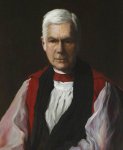
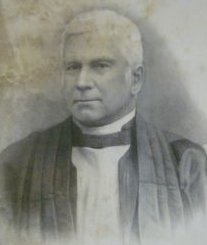
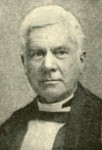
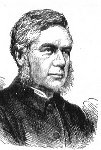 PRECURSORS
PRECURSORS
Since
1895 the Diocese of London has had a suffragan, or area, Bishop of
Stepney, responsible for East London. From 1879-88 William
Walsham How (1823-97) - known as 'Walsham' - [right at various periods of his life - final picture by Hugh Littleton Norris, 1897, held at Wadham College, Oxford] was
suffragan Bishop of Bedford
(prior to the creation of the diocese of St
Alban's), who performed a similar function. It irked him greatly that
some commentators assumed his area of responsibility was primarily
rural - though his roots were in Shropshire, and he came to
London after more than thirty years ministry there: son of a Shrewsbury
solicitor from Cumbria, after Shrewsbury School, Wadham College Oxford,
and
University College Durham, he was ordained to a curacy at Kidderminster
in 1846 (his incumbent became Bishop of St Albans), returning 'for
family reasons' as curate of Shrewsbury Abbey from 1848, then for 28
years from 1851 was Rector of
Whittington (and Rural Dean of Oswestry from 1854, honorary canon of St
Asaph in 1860, and Proctor in Convocation 1868). He became known as a
devotional writer and effective leader of missions, retreats and quiet
days, and is said to have declined the bishoprics of Natal (1867), New
Zealand (1868), Montreal (1869), Cape Town (1873), and Jamaica (1878),
besides a canonry, with superintendence of home mission work, at
Winchester (1878), and the important livings of Brighton (1870), All
Saints', Margaret Street (1873), and Windsor, with a readership to the
queen (1878). But the following year he agreed to become a suffragan
bishop and 'leader of an East End crusade'. The City parish of St Andrew Undershaft with
St Mary-at-Axe, of which he became titular Rector the day after his consecration, provided his stipend.
 In
London, he lived at Stainforth House, Upper Clapton - provided free of
charge by its owner for this 'crusade'. Though small in stature and
a 'plain' preacher, he was much-loved by all (see this
example from Christ Church Watney Street), produced much devotional
material for church workers, and was very energetic - among other
things, creating in 1880 the East London Church Fund
to
support ministry in poor parishes (as the magazine wrapper shown in
this link demonstrates, in later years its reports went out in the
joint names of the Bishops of Stepney and Islington). On one occasion
he preached in
the kitchen of a large lodging house; on another, he attended the Feast
of Tabernacles in a local synagogue and sat in a prominent seat - a
common-enough gesture now, but not then. He was known as the
'children's bishop'. Bishop
Jackson, the diocesan, gave him a free hand and did not interfere,
unlike his successor Frederick Temple, appointed in 1885. In 1888,
because of these changes, and the death of his first wife, How
became first Bishop of Wakefield, until his death in 1897 (where he
signed himself William Walsham Wakefield or simply W.W.W.)
He wrote several hymns, including For all the saints; and also, while in London, sonnets about some of the local clergy, including Charles Lowder (of St George's Mission and then Rector of St Peter, London Docks) and Harry Jones (Rector of St George-in-the-East 1873-82). He
shared with Harry Jones a love of Switzerland, and both were involved
in building churches there for English tourists. In 1882 he consecrated
Holy Trinity Church in Pontresina, part-funded by Princess Christian
(Queen Victoria's daughter Helena, wife of a Danish/German prince): a
2016-17 exhibition at the Museum Alpin in Pontresina will tell its
story. Bishop How's son Frederick Douglas produced a Memoir
(Isbister 1899); this records how, the day before the consecration of
this church, he wrote to his curate at St Andrew Undershaft:
In
London, he lived at Stainforth House, Upper Clapton - provided free of
charge by its owner for this 'crusade'. Though small in stature and
a 'plain' preacher, he was much-loved by all (see this
example from Christ Church Watney Street), produced much devotional
material for church workers, and was very energetic - among other
things, creating in 1880 the East London Church Fund
to
support ministry in poor parishes (as the magazine wrapper shown in
this link demonstrates, in later years its reports went out in the
joint names of the Bishops of Stepney and Islington). On one occasion
he preached in
the kitchen of a large lodging house; on another, he attended the Feast
of Tabernacles in a local synagogue and sat in a prominent seat - a
common-enough gesture now, but not then. He was known as the
'children's bishop'. Bishop
Jackson, the diocesan, gave him a free hand and did not interfere,
unlike his successor Frederick Temple, appointed in 1885. In 1888,
because of these changes, and the death of his first wife, How
became first Bishop of Wakefield, until his death in 1897 (where he
signed himself William Walsham Wakefield or simply W.W.W.)
He wrote several hymns, including For all the saints; and also, while in London, sonnets about some of the local clergy, including Charles Lowder (of St George's Mission and then Rector of St Peter, London Docks) and Harry Jones (Rector of St George-in-the-East 1873-82). He
shared with Harry Jones a love of Switzerland, and both were involved
in building churches there for English tourists. In 1882 he consecrated
Holy Trinity Church in Pontresina, part-funded by Princess Christian
(Queen Victoria's daughter Helena, wife of a Danish/German prince): a
2016-17 exhibition at the Museum Alpin in Pontresina will tell its
story. Bishop How's son Frederick Douglas produced a Memoir
(Isbister 1899); this records how, the day before the consecration of
this church, he wrote to his curate at St Andrew Undershaft:| ...
we went a glacier expedition. We had a guide, but no rope, as it was
thought pretty safe, but the newly fallen snow was treacherous, and one
of our party, an elderly gentleman, fell into a deep crevasse, twenty
or thirty feet down, and quite out of sight. It was very anxious work,
as we had to send a long way for a rope, and there he had to stay. We
could shout down to him, and he up to us, and, most mercifully, he was
not seriously hurt, only jambed in the ice. When the guide brought the
rope and some other men he had some difficulty in getting it round his
chest, but did at last manage it, and then some seven or eight good
hauls by four strong men brought him up. Some of
us could not help bursting into tears when he was saved, and the Bishop
of Gloucester, who was with us, and who is an experienced Alpine
climber, gathered us all together on the ice (we were a party of about
twelve), and offered up a thanksgiving, and then we all sang the
Doxology together. It was very affecting. I had only just crossed the
dangerous spot, and, on hearing the shout of an accident, turned round
to go and see, and slipped and twisted my left knee. A shade more and I
could not have got away, and, as it was, I had to walk two hours more
over the ice, often very dangerous, limping in great pain. I can only
just hobble with a stick today. We all feel we had a lesson in caution
in glacier work. |
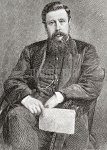 Walsham How's successor as Bishop of Bedford from 1888-98 was Robert Claudius Billing [left from the Strand magazine in 1894], though he resigned his duties from 1895, when his health broke down. Born
in Maidstone in 1834 to a clerical family, he studied at Wye College,
and Worcester
College Oxford, and was ordained in 1857 to the curacy of St Peter
Colchester [then in Rochester diocese]; was curate of Compton Bishop,
Somerset from 1861 and also secretary of the Church Missionary Society
until 1863, when he became Vicar of Louth in Lincolnshire (remaining
with CMS as an honorary assistant secretary), and Chaplain of the Manor
of Worlaby [near Brigg in Lincolnshire] in 1870, before coming to
London, as Vicar of Holy Trinity Islington from 1873-78 and Rector of
Spitalfields from 1878, and Rural Dean. He edited Missionary Leaves
for CMS. From 1891, like his predecessor, he was titular Rector of St Andrew Undershaft with
St Mary-at-Axe. He was a keen supporter of
the volunteer movement, and chaplain of the 2nd Tower Hamlets
Volunteers. On his death (aged 63) the
title of Bishop of Bedford lapsed, until a suffragan of St Alban's was appointed in
1935.
Walsham How's successor as Bishop of Bedford from 1888-98 was Robert Claudius Billing [left from the Strand magazine in 1894], though he resigned his duties from 1895, when his health broke down. Born
in Maidstone in 1834 to a clerical family, he studied at Wye College,
and Worcester
College Oxford, and was ordained in 1857 to the curacy of St Peter
Colchester [then in Rochester diocese]; was curate of Compton Bishop,
Somerset from 1861 and also secretary of the Church Missionary Society
until 1863, when he became Vicar of Louth in Lincolnshire (remaining
with CMS as an honorary assistant secretary), and Chaplain of the Manor
of Worlaby [near Brigg in Lincolnshire] in 1870, before coming to
London, as Vicar of Holy Trinity Islington from 1873-78 and Rector of
Spitalfields from 1878, and Rural Dean. He edited Missionary Leaves
for CMS. From 1891, like his predecessor, he was titular Rector of St Andrew Undershaft with
St Mary-at-Axe. He was a keen supporter of
the volunteer movement, and chaplain of the 2nd Tower Hamlets
Volunteers. On his death (aged 63) the
title of Bishop of Bedford lapsed, until a suffragan of St Alban's was appointed in
1935.
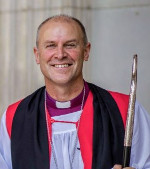 From 1898 to 1923
there was a
Bishop of Islington, again financed by the Rectory of St Andrew Undershaft, and living at Stainforth House - Charles Henry Turner,
Rector of St George-in-the-East prior to his consecration; the title
was then in abeyance until 2015, when Ric Thorpe, from St Paul Shadwell
- right - was consecrated to the post as a bishop for church planting.
From 1898 to 1923
there was a
Bishop of Islington, again financed by the Rectory of St Andrew Undershaft, and living at Stainforth House - Charles Henry Turner,
Rector of St George-in-the-East prior to his consecration; the title
was then in abeyance until 2015, when Ric Thorpe, from St Paul Shadwell
- right - was consecrated to the post as a bishop for church planting.
1895: BISHOP OF STEPNEY
The
episcopal area of Stepney (and Archdeaconry of Hackney) comprises what are now the three deaneries of Tower Hamlets, Hackney
and Islington, more-or-less co-terminous with the London
boroughs of these names, though the rural/area deanery boundaries have
changed many times over the years.
For some years - certainly during the time of Bishops Mosley, Curzon and Moberly, and maybe before and after - the post was funded by the income of the City parishes of St Margaret Lothbury with St Christopher-le-Stocks, St Bartholomew Exchange, St Olave Old Jewry, St Martin Pomeroy, St Mildred Poultry, and St Mary Colechurch, with a combined population of 51 and an annual income of over £2000 plus a house; they were also titular Rectors of these parishes.
The
roll-call is a distinguished one: many moved on to become diocesan
bishops or archbishops, at home and overseas, and East Enders have
taken pride in this. Even
those for whom Stepney seemed (to local chagrin) a stepping stone, rather than a
long-term commitment, took to their posts elsewhere the
experience of the particular joys, sorrows and challenges of urban
ministry. They did not always live in their 'patch' - Browne, Lang and Lunt, for
example, lived in Amen Court, by St Paul's Cathedral (since they were also residentiary canons there), and Curzon
moved to a house in Bedford Square WC1 on the grounds
that this was more central and accessible; but Moberly lived in
Islington, and more recent successors
believed it was vital to live in the East End. Trevor Huddleston lived
at 400 Commercial Road
(the former parsonage house of one of our district churches),
as did Jim Thompson before he moved further east to a smaller house;
this proved too small, so the current see house is a former parsonage
in Coborn Road, Mile End.
Where possible, they
are pictured below at various stages of their ministry - in Stepney and
later. Many of these images are held by the National Portrait Gallery. Trevor Beeson The Bishops (SCM 2003) has interesting comments on a number of them; some have full-blown biographies!
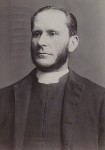
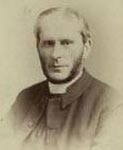
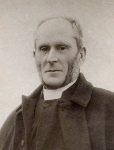
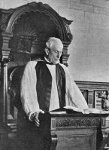 1: 1895-97 George Forrest Browne (1833-1930)
graduated in Maths (as a Wrangler) and Theology from St Catherine's
College Cambridge, where he was subsequently a Fellow, Chaplain and
Lecturer, and held various other administrative and academic offices in the university:
he was Disney Professor of Archaeology from
1887-92. As a pioneer
explorer of ice caves, he published Ice Caves in France & Switzerland (1864) and Off the Mill
(Smith 1895), and various other works on archaeology in retirement.
Ordained in 1858,
he was as schoolmaster in Scotland, and on his return to Cambridge
Rector of Ashley-cum-Silverley. He became Canon Treasurer of St Paul's
Cathedral in
1891, combining this post with that of Bishop of Stepney from 1895.
Just two years later he was
translated to Bristol, where he remained until retirement in 1914; he
wrote several books on church history and lives
of the
saints, including Lessons from Early English Church History (1893), The Church in These Islands before Augustine (1894), Augustine and his Companions (1895), Theodore & Wilfrith (1897), The Life and Times of Aldhelm (1903),
Alcuin of York (1908), The Venerable Bede (1919) as well as a History of St Catharine's College Cambridge (1892). In retirement he ived in Campden House Road, Kensington. [photographs (1)
1890s (2) 1895 (3) c1907 (4) preaching in later life]
1: 1895-97 George Forrest Browne (1833-1930)
graduated in Maths (as a Wrangler) and Theology from St Catherine's
College Cambridge, where he was subsequently a Fellow, Chaplain and
Lecturer, and held various other administrative and academic offices in the university:
he was Disney Professor of Archaeology from
1887-92. As a pioneer
explorer of ice caves, he published Ice Caves in France & Switzerland (1864) and Off the Mill
(Smith 1895), and various other works on archaeology in retirement.
Ordained in 1858,
he was as schoolmaster in Scotland, and on his return to Cambridge
Rector of Ashley-cum-Silverley. He became Canon Treasurer of St Paul's
Cathedral in
1891, combining this post with that of Bishop of Stepney from 1895.
Just two years later he was
translated to Bristol, where he remained until retirement in 1914; he
wrote several books on church history and lives
of the
saints, including Lessons from Early English Church History (1893), The Church in These Islands before Augustine (1894), Augustine and his Companions (1895), Theodore & Wilfrith (1897), The Life and Times of Aldhelm (1903),
Alcuin of York (1908), The Venerable Bede (1919) as well as a History of St Catharine's College Cambridge (1892). In retirement he ived in Campden House Road, Kensington. [photographs (1)
1890s (2) 1895 (3) c1907 (4) preaching in later life]
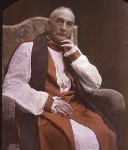
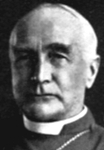
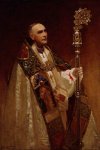
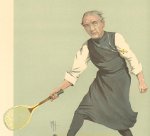
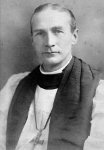
 2: 1897-1901 Arthur
Foley Winnington-Ingram (1858-1946),
then Bishop of London
for 38 years until his retirement in 1939 at the age of 81, was born in
Worcestershire (his father was a parson, his mother a bishop's
daughter); he studied at Keble College Oxford, and was a private tutor and
then a curate in Shrewsbury and chaplain to the Bishop of Lichfield
before coming to the East End as head of
the Oxford House settlement in Bethnal Green from 1888-97 (it's still
there, now doing work appropriate for the 21st century): while there,
he was also chaplain to the Bishop of St Albans and the Archbishop of
York. At Oxford House, and then as Bishop of Stepney, he was a
pioneer of social work initiatives in London - and, it's said, his
accent took on a slight East End twang that he never lost. He never married,
though during his time at Stepney was briefly engaged to Lady Ulrica
Duncombe. The most controversial aspect of his time as Bishop of London
was his uncritical stance during the First World War, and his 1927-28 world tour also
attracted attention, when he was picked on by the Soviets. Because
he was in office so long, he rather 'lost the plot' in terms of clergy
discipline and other aspects of diocesan organisation. He wrote many
books (including one in 1901 with the intriguing title The Afterglow of a
Great Reign), particularly around the War years, and later
published an
autobiography Arthur Foley Winnington-Ingram, D.D., K.C.V.O., Fifty Years' Work in London (1889-1939) (Longmans Green 1940); after his death S.C. Carpenter (Dean of Exeter) wrote The Biography of Arthur Foley Winnington-Ingram, Bishop of London 1901-1939 (Hodder & Stoughton 1949). [Pictures
show him at the time of his appointment to London (1) from Vanity Fair
1901, & (2); (3) Vanity Fair in 1912; (4) painting of 1918; (5)
& (6) later in his
ministry and (7) a painting of c1939 by Alice Mary Burton, from
the Fulham Palace collection]
2: 1897-1901 Arthur
Foley Winnington-Ingram (1858-1946),
then Bishop of London
for 38 years until his retirement in 1939 at the age of 81, was born in
Worcestershire (his father was a parson, his mother a bishop's
daughter); he studied at Keble College Oxford, and was a private tutor and
then a curate in Shrewsbury and chaplain to the Bishop of Lichfield
before coming to the East End as head of
the Oxford House settlement in Bethnal Green from 1888-97 (it's still
there, now doing work appropriate for the 21st century): while there,
he was also chaplain to the Bishop of St Albans and the Archbishop of
York. At Oxford House, and then as Bishop of Stepney, he was a
pioneer of social work initiatives in London - and, it's said, his
accent took on a slight East End twang that he never lost. He never married,
though during his time at Stepney was briefly engaged to Lady Ulrica
Duncombe. The most controversial aspect of his time as Bishop of London
was his uncritical stance during the First World War, and his 1927-28 world tour also
attracted attention, when he was picked on by the Soviets. Because
he was in office so long, he rather 'lost the plot' in terms of clergy
discipline and other aspects of diocesan organisation. He wrote many
books (including one in 1901 with the intriguing title The Afterglow of a
Great Reign), particularly around the War years, and later
published an
autobiography Arthur Foley Winnington-Ingram, D.D., K.C.V.O., Fifty Years' Work in London (1889-1939) (Longmans Green 1940); after his death S.C. Carpenter (Dean of Exeter) wrote The Biography of Arthur Foley Winnington-Ingram, Bishop of London 1901-1939 (Hodder & Stoughton 1949). [Pictures
show him at the time of his appointment to London (1) from Vanity Fair
1901, & (2); (3) Vanity Fair in 1912; (4) painting of 1918; (5)
& (6) later in his
ministry and (7) a painting of c1939 by Alice Mary Burton, from
the Fulham Palace collection]

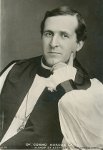
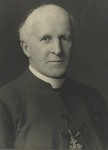
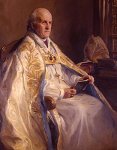
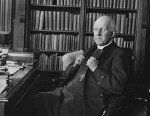
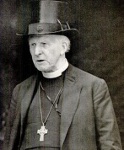 3: 1901-09 William Cosmo Gordon
Lang (1864-1945): Cosmo
Lang was the son of a Scots Presbyterian minister, with no great
religious interest as a student at Balliol - he was destined for the
bar - until he became convinced that he should seek ordination. His was
a moderate catholic by inclination, combining the fruits of the Oxford
Movement with the liberal views of Lux Mundi and
the heirs of F.D. Maurice and Charles Kingsley (much later he was an
early advocate of the Parish Communion movement, and was the first
modern archbishop to wear cassock [black, not purple] rather than
gaiters as day dress - despite the final photograph! - and to wear rather
than carry a mitre in church). He served a curacy at
Leeds Parish Church in 1900, returning to Oxford three years later to
fellowships at All Souls and Magdalen, examining chaplaincies and a
period as Vicar of the University Church. From 1896-1901 he was Vicar
of Portsea, a famous 'slum' parish with a large and regimented staff
(where many other future bishops served), and in 1901 was consecrated
for Stepney, with a canonry and house at St Paul's [pictures (1) - Vanity Fair cartoon 1906, 'A Bishop of Decision' - and (2)]. Controversially -
for he was only 44, and a 'mere' suffragan - he was appointed
Archbishop of York in 1908. Perhaps mindful of his Stepney days, he
spoke in the House of Lords in favour of Lloyd George's People's Budget
of 1909, though this radical flash did not persist. Controversy
surrounded a speech early in the First World War in which he displayed
sympathy for the German emperor; the stress probably resulted in the
alopecia that changed his appearance [compare photo (3) and following]. In the 1920s he
promoted Christian unity and supported Prayer Book reform (a cause
which failed and 'went dead' for several decades), and worked closely
with fellow-Scot Randall Davidson at Canterbury, whom he succeeded in that office in
1928 until his retirement in 1942, remaining a member of the House of
Lords until his death. A friend of royalty - as early as 1899 he had
been a chaplain to Queen Victoria - he was much troubled by Edward
VIII's intention to marry a divorcée, and relieved when others
(apparently) brokered the abdication, though his speech after the event
was much-criticised. Trevor Beeson's assessment is By conviction he remained unmarried, the better to give himself to his work [like
his predecessor: note that Michael Gove and David Starkey are among
those who have speculated, on slender evidence, that he was a latent
homosexual]. Dignified, handsome, a master of ecclesiastical ceremony, he was also
an able and conscientious administrator and a gracious and charming
host to both high and low ... if Davidson was the statesman, Lang was the churchman. His primary biographer was J.G. Lockhart Cosmo Gordon Lang (Hodder 1949); the Wikipedia article is full and reasonably balanced; and see also Alan Wilkinson's 2004 Oxford Dictionary of National Biography entry, and Robert Beaken Cosmo Lang: Archbishop in War and Crisis (I.B. Tauris 2012) which accesses fresh material.
3: 1901-09 William Cosmo Gordon
Lang (1864-1945): Cosmo
Lang was the son of a Scots Presbyterian minister, with no great
religious interest as a student at Balliol - he was destined for the
bar - until he became convinced that he should seek ordination. His was
a moderate catholic by inclination, combining the fruits of the Oxford
Movement with the liberal views of Lux Mundi and
the heirs of F.D. Maurice and Charles Kingsley (much later he was an
early advocate of the Parish Communion movement, and was the first
modern archbishop to wear cassock [black, not purple] rather than
gaiters as day dress - despite the final photograph! - and to wear rather
than carry a mitre in church). He served a curacy at
Leeds Parish Church in 1900, returning to Oxford three years later to
fellowships at All Souls and Magdalen, examining chaplaincies and a
period as Vicar of the University Church. From 1896-1901 he was Vicar
of Portsea, a famous 'slum' parish with a large and regimented staff
(where many other future bishops served), and in 1901 was consecrated
for Stepney, with a canonry and house at St Paul's [pictures (1) - Vanity Fair cartoon 1906, 'A Bishop of Decision' - and (2)]. Controversially -
for he was only 44, and a 'mere' suffragan - he was appointed
Archbishop of York in 1908. Perhaps mindful of his Stepney days, he
spoke in the House of Lords in favour of Lloyd George's People's Budget
of 1909, though this radical flash did not persist. Controversy
surrounded a speech early in the First World War in which he displayed
sympathy for the German emperor; the stress probably resulted in the
alopecia that changed his appearance [compare photo (3) and following]. In the 1920s he
promoted Christian unity and supported Prayer Book reform (a cause
which failed and 'went dead' for several decades), and worked closely
with fellow-Scot Randall Davidson at Canterbury, whom he succeeded in that office in
1928 until his retirement in 1942, remaining a member of the House of
Lords until his death. A friend of royalty - as early as 1899 he had
been a chaplain to Queen Victoria - he was much troubled by Edward
VIII's intention to marry a divorcée, and relieved when others
(apparently) brokered the abdication, though his speech after the event
was much-criticised. Trevor Beeson's assessment is By conviction he remained unmarried, the better to give himself to his work [like
his predecessor: note that Michael Gove and David Starkey are among
those who have speculated, on slender evidence, that he was a latent
homosexual]. Dignified, handsome, a master of ecclesiastical ceremony, he was also
an able and conscientious administrator and a gracious and charming
host to both high and low ... if Davidson was the statesman, Lang was the churchman. His primary biographer was J.G. Lockhart Cosmo Gordon Lang (Hodder 1949); the Wikipedia article is full and reasonably balanced; and see also Alan Wilkinson's 2004 Oxford Dictionary of National Biography entry, and Robert Beaken Cosmo Lang: Archbishop in War and Crisis (I.B. Tauris 2012) which accesses fresh material.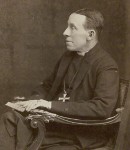 4: 1909-19 Henry Luke Paget
(1853-1937 - right c1906)
always claimed his happiest years were in urban ministry, despite two
rural bishoprics. He studied at Christ
Church Oxford and served his title at the Tractarian church of St
Andrew Wells Street, Marylebone from 1877 under
Benjamin Webb (co-founder of the Cambridge Camden Society which
campaigned for 'correct' liturgical architecture). After two years as
vice-principal of Leeds Clergy School he returned to London in 1881 to
the Christ Church mission house in East London. After just a year as
Vicar of St Ives (in Ely diocese) he was back in London as Vicar of St
Pancras from 1887 (latterly also
serving as rural dean and as a chaplain to his brother Francis,
who was Bishop of Oxford) until his consecration as a bishop. This was in 1906 (unusually, at
his 'own' church of St Pancras, rather than at St Paul's Cathedral), to the suffragan see of
Ipswich, then part of Norwich diocese (also holding the Rectory of Nacton with
Levington). This see was left vacant when he was translated to Stepney
three years later; in 1914 the new diocese of St Edmundsbury & Ipswich was created.
4: 1909-19 Henry Luke Paget
(1853-1937 - right c1906)
always claimed his happiest years were in urban ministry, despite two
rural bishoprics. He studied at Christ
Church Oxford and served his title at the Tractarian church of St
Andrew Wells Street, Marylebone from 1877 under
Benjamin Webb (co-founder of the Cambridge Camden Society which
campaigned for 'correct' liturgical architecture). After two years as
vice-principal of Leeds Clergy School he returned to London in 1881 to
the Christ Church mission house in East London. After just a year as
Vicar of St Ives (in Ely diocese) he was back in London as Vicar of St
Pancras from 1887 (latterly also
serving as rural dean and as a chaplain to his brother Francis,
who was Bishop of Oxford) until his consecration as a bishop. This was in 1906 (unusually, at
his 'own' church of St Pancras, rather than at St Paul's Cathedral), to the suffragan see of
Ipswich, then part of Norwich diocese (also holding the Rectory of Nacton with
Levington). This see was left vacant when he was translated to Stepney
three years later; in 1914 the new diocese of St Edmundsbury & Ipswich was created.
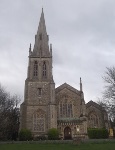 Left is a report of the 25th anniversary of the Hebrew Guild of Intercession at which he pronounced the absolution and blessing in Hebrew. In the period up to the end of the First World War he was the select
preacher both at Oxford and Cambridge on several occasions. To the
surprise of some, after ten years in Stepney, at the age of 66, he
was preferred to the diocesan bishopric of Chester, though he managed to serve a further
13 years there. He died aged 83 at a nursing home in Bournemouth, and
was buried, according to his wishes, at St Andrew Kingsbury - the 1847 Wells
Street church which had been rebuilt there stone by stone [right in its new location] - he
was present at its re-consecration in 1934, and was very moved to
see
again the communion vessels he had handled as a curate. (Today it is a
'Fulham jurisdiction' parish, opposed to the ordained ministry of
women.) A definite but
open anglo-catholic, sometimes
said to to be the 'last of the Tractarian bishops', he was a close
friend of Fr Wainwright at St Peter
London Docks. He is
said to have recited the psalms from memory at the daily office; he was
much-loved. His father (Sir James Paget) and brother were medics, and a
son
was an architect. His wife
Elma Katie Gurney Hoare (a prolific author, under the name of Elma K.
Paget) wrote a
biography
Henry Luke Paget (Longmans, Green 1939).
Left is a report of the 25th anniversary of the Hebrew Guild of Intercession at which he pronounced the absolution and blessing in Hebrew. In the period up to the end of the First World War he was the select
preacher both at Oxford and Cambridge on several occasions. To the
surprise of some, after ten years in Stepney, at the age of 66, he
was preferred to the diocesan bishopric of Chester, though he managed to serve a further
13 years there. He died aged 83 at a nursing home in Bournemouth, and
was buried, according to his wishes, at St Andrew Kingsbury - the 1847 Wells
Street church which had been rebuilt there stone by stone [right in its new location] - he
was present at its re-consecration in 1934, and was very moved to
see
again the communion vessels he had handled as a curate. (Today it is a
'Fulham jurisdiction' parish, opposed to the ordained ministry of
women.) A definite but
open anglo-catholic, sometimes
said to to be the 'last of the Tractarian bishops', he was a close
friend of Fr Wainwright at St Peter
London Docks. He is
said to have recited the psalms from memory at the daily office; he was
much-loved. His father (Sir James Paget) and brother were medics, and a
son
was an architect. His wife
Elma Katie Gurney Hoare (a prolific author, under the name of Elma K.
Paget) wrote a
biography
Henry Luke Paget (Longmans, Green 1939).
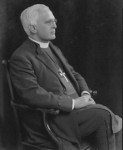 5: 1919-28 Henry Mosley (1868-1948), left
- from Newcastle-under-Lyne, he studied at Keble College
Oxford and trained for ordination at Ely College, beginning his
ministry at St Andrew Bethnal Green in 1893, moving to Trinity
College's mission at Stratford in 1898, and becoming Rector of All
Saints Poplar in 1902 - where J.C. Pringle, future Rector of our parish, was his curate - moving to
St John-at-Hackney in 1911 (where he was rural dean of Hackney and
Stoke Newington from 1917, and also a commissary for the church in
Korea). So he too had impeccable credentials for a Stepney episcopate, and was an urban priest at heart. In a farewell letter to East London churches [photograph left from that year] he wrote I will not attempt to tell you what a heartache it gives me to think of
leaving East London after 37 years ... It was a hard decision to make.
Last March, when you presented me with that beautiful motor-car, I
looked forward to using it in East London for many a day to come. But
that is not to be, and the car will now become a most treasured
farewell gift from you all. He
had been 'promoted' to become Bishop of Southwell, a mainly rural
diocese at that time (telephone 'Southwell 12'), where he remained
until retirement in 1941 - serving on the
Council for the Church and the Countryside; he died at
Kingsclere in 1948. His daughter Dame Betty
Ridley was a Church Commissioner and a leading advocate for women's ordination.
5: 1919-28 Henry Mosley (1868-1948), left
- from Newcastle-under-Lyne, he studied at Keble College
Oxford and trained for ordination at Ely College, beginning his
ministry at St Andrew Bethnal Green in 1893, moving to Trinity
College's mission at Stratford in 1898, and becoming Rector of All
Saints Poplar in 1902 - where J.C. Pringle, future Rector of our parish, was his curate - moving to
St John-at-Hackney in 1911 (where he was rural dean of Hackney and
Stoke Newington from 1917, and also a commissary for the church in
Korea). So he too had impeccable credentials for a Stepney episcopate, and was an urban priest at heart. In a farewell letter to East London churches [photograph left from that year] he wrote I will not attempt to tell you what a heartache it gives me to think of
leaving East London after 37 years ... It was a hard decision to make.
Last March, when you presented me with that beautiful motor-car, I
looked forward to using it in East London for many a day to come. But
that is not to be, and the car will now become a most treasured
farewell gift from you all. He
had been 'promoted' to become Bishop of Southwell, a mainly rural
diocese at that time (telephone 'Southwell 12'), where he remained
until retirement in 1941 - serving on the
Council for the Church and the Countryside; he died at
Kingsclere in 1948. His daughter Dame Betty
Ridley was a Church Commissioner and a leading advocate for women's ordination.
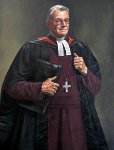
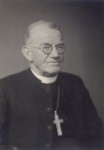
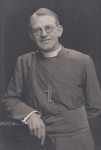 6: 1928-36 Charles Edward Curzon (1878-1954)
was born in London but attended Lancaster Royal Grammar School; after
Christ's College Cambridge and Salisbury Theological College, he was
ordained in 1901 as curate of St Andrew Fulham and then, after a short
period as secretary
of the Additional Curates Society, was Vicar of St Oswald Millhouses,
in south Sheffield, then of Goole. Returning to London in 1920, he held
another administrative post as secretary of the London Diocesan Fund,
plus a brief incumbency at St Barnabas Kensington, before his
consecration. He became Bishop of Exeter in 1936 (where he published
various pamphlets, for Lent courses and the like) until his retirement
in 1948 to Hatfield, Herts; he died in 1954. [prints (1) 1920-40 by Albert Howard Hester, (2) 1945 by Walter Stoneman; (3) painting by John Mansbridge, for Exeter
Palace]
6: 1928-36 Charles Edward Curzon (1878-1954)
was born in London but attended Lancaster Royal Grammar School; after
Christ's College Cambridge and Salisbury Theological College, he was
ordained in 1901 as curate of St Andrew Fulham and then, after a short
period as secretary
of the Additional Curates Society, was Vicar of St Oswald Millhouses,
in south Sheffield, then of Goole. Returning to London in 1920, he held
another administrative post as secretary of the London Diocesan Fund,
plus a brief incumbency at St Barnabas Kensington, before his
consecration. He became Bishop of Exeter in 1936 (where he published
various pamphlets, for Lent courses and the like) until his retirement
in 1948 to Hatfield, Herts; he died in 1954. [prints (1) 1920-40 by Albert Howard Hester, (2) 1945 by Walter Stoneman; (3) painting by John Mansbridge, for Exeter
Palace]
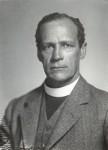
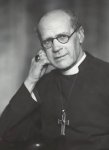
 7: 1936-52 Robert Hamilton Moberly
(1884-1978)
was a protegé of his predecessor Paget, and a member of a
distinguished clerical family: his grandfather George was a bishop, and
his father
Robert Campbell Moberly the author of the classic, still-read, works Ministerial Priesthood (1897) and Atonement and Personality (1901).
He was a scholar of New College Oxford and
trained at Cuddesdon; ordained in 1909 to a village parish in Kent (St
Margaret-at-Cliffe), in 1914 he began an 11-year stint at Benoni, in
the Transvaal, which included a period as a chaplain during the First
World War and work with the bishops of Pretoria and Johannesburg - he
continued as a commissary for Southern Rhodesia until he left Stepney.
In
1925 be became Principal of Bishops' College, Cheshunt [right], a theological college taken over from the Countess of Huntingdon's Connexion
in 1909, sponsored by the Bishops of St Alban's, London, Southwark and
Chelmsford (it closed in 1969). He was consecrated for Stepney in
1936 and left in 1952 to become Dean of Salisbury, retiring in 1960
with permission to officiate in Ely until 1966; he then lived in West
Wittering, Sussex until his death in 1978. [photos from 1930s, and in later life]
7: 1936-52 Robert Hamilton Moberly
(1884-1978)
was a protegé of his predecessor Paget, and a member of a
distinguished clerical family: his grandfather George was a bishop, and
his father
Robert Campbell Moberly the author of the classic, still-read, works Ministerial Priesthood (1897) and Atonement and Personality (1901).
He was a scholar of New College Oxford and
trained at Cuddesdon; ordained in 1909 to a village parish in Kent (St
Margaret-at-Cliffe), in 1914 he began an 11-year stint at Benoni, in
the Transvaal, which included a period as a chaplain during the First
World War and work with the bishops of Pretoria and Johannesburg - he
continued as a commissary for Southern Rhodesia until he left Stepney.
In
1925 be became Principal of Bishops' College, Cheshunt [right], a theological college taken over from the Countess of Huntingdon's Connexion
in 1909, sponsored by the Bishops of St Alban's, London, Southwark and
Chelmsford (it closed in 1969). He was consecrated for Stepney in
1936 and left in 1952 to become Dean of Salisbury, retiring in 1960
with permission to officiate in Ely until 1966; he then lived in West
Wittering, Sussex until his death in 1978. [photos from 1930s, and in later life]

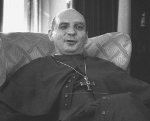


 8: 1952-57 Joost
de Blank (1908-68)
was a powerful and complex character. Born in Rotterdam to Dutch
Reformed parents who worshipped at the Presbyterian church in Ealing
when his father came to work for Unilever, he attended Merchant
Taylors' School, King's College London and (after a year learning
useful journalism skills) read English and Law at
Queens' College Cambridge. He shed Calvinism, but trained for
ordination at Ridley Hall, an evangelical college, and embraced the
Moral Re-Armament
cause - indeed, during his second curacy in Bath & Wells
diocese he was a regional organiser. He forsook this when he became
Vicar of Emmanuel, Forest Gate (a parish of 12,000) in 1937, and also -
because convinced of the evils of Nazism - his pacifist
convictions, to
serve as an army chaplain, in North Africa and Italy. In 1944 he was
injured at a confirmation in Antwerp where he was one of only four
survivors when a German V2 rocket hit the building; this left him
facially scarred, and with severe lifelong headaches. He then tried his
hand as a
Student Christian Movement secretary, but this did not suit, and in
1948 he took on another large and challenging parish, St John Greenhill
in Harrow, which thrived under his flamboyant style (he related more
easily men than to women, though the journalist and writer Monica Furlong was a devotee). By now he was a 'Parish and People' man,
stressing the centrality of the eucharist coupled with social action,
and wrote The Parish in Action (1954 - pictured - one of several similar books from that period: see Donald Gray Earth & Altar 1986).
He was equally vigorous during his five years at Stepney, re-organising
parishes into teams. In 1957 he was appointed Archbishop of Cape Town. Despite
being an outsider and an autocrat, Trevor Beeson says he was the right man in the right place at the right time. His
Dutch background may have led the Afrikaners to expect an appeaser,
like his fellow-bishops, but at his consecration he courageously
announced It is my conviction that
racial discrimination is a form of blasphemy, and that those who
condone it or allow it without protest place their souls in eternal
peril ... Sin is sin, and has to be repented of and forsaken completely
- here and now. He refused to preach in churches not open to
blacks and whites, and opposed clause 29 of the Natives Law Amendment
Bill which gave power to exclude non-white Anglicans from churches. He
called on the government to repudiate apartheid, and described the
jubilee celebrations as no time for rejoicing but for shame.
Dubbed the 'scourge of apartheid', he continued to live at a frantic
pace under the spotlight (usually in a vivid purple cassock, with an entourage of curates) until 1962
when he had a cerebral thrombosis; he resigned the following year, unable to continue on a half-hearted basis. His
final years were as a canon of Westminster Abbey, and Sub-Prelate of
the Order of St John of Jerusalem, where he described himself as a caged lion, though he was a prolific speaker around the country, and published papers and addresses under the title of Out of Africa (1964). He was nominated as Bishop of Hong
Kong in 1966, but his health ruled this out. His memorial tablet at the
Abbey describes him as an 'Indomitable Fighter for Human Rights'.
8: 1952-57 Joost
de Blank (1908-68)
was a powerful and complex character. Born in Rotterdam to Dutch
Reformed parents who worshipped at the Presbyterian church in Ealing
when his father came to work for Unilever, he attended Merchant
Taylors' School, King's College London and (after a year learning
useful journalism skills) read English and Law at
Queens' College Cambridge. He shed Calvinism, but trained for
ordination at Ridley Hall, an evangelical college, and embraced the
Moral Re-Armament
cause - indeed, during his second curacy in Bath & Wells
diocese he was a regional organiser. He forsook this when he became
Vicar of Emmanuel, Forest Gate (a parish of 12,000) in 1937, and also -
because convinced of the evils of Nazism - his pacifist
convictions, to
serve as an army chaplain, in North Africa and Italy. In 1944 he was
injured at a confirmation in Antwerp where he was one of only four
survivors when a German V2 rocket hit the building; this left him
facially scarred, and with severe lifelong headaches. He then tried his
hand as a
Student Christian Movement secretary, but this did not suit, and in
1948 he took on another large and challenging parish, St John Greenhill
in Harrow, which thrived under his flamboyant style (he related more
easily men than to women, though the journalist and writer Monica Furlong was a devotee). By now he was a 'Parish and People' man,
stressing the centrality of the eucharist coupled with social action,
and wrote The Parish in Action (1954 - pictured - one of several similar books from that period: see Donald Gray Earth & Altar 1986).
He was equally vigorous during his five years at Stepney, re-organising
parishes into teams. In 1957 he was appointed Archbishop of Cape Town. Despite
being an outsider and an autocrat, Trevor Beeson says he was the right man in the right place at the right time. His
Dutch background may have led the Afrikaners to expect an appeaser,
like his fellow-bishops, but at his consecration he courageously
announced It is my conviction that
racial discrimination is a form of blasphemy, and that those who
condone it or allow it without protest place their souls in eternal
peril ... Sin is sin, and has to be repented of and forsaken completely
- here and now. He refused to preach in churches not open to
blacks and whites, and opposed clause 29 of the Natives Law Amendment
Bill which gave power to exclude non-white Anglicans from churches. He
called on the government to repudiate apartheid, and described the
jubilee celebrations as no time for rejoicing but for shame.
Dubbed the 'scourge of apartheid', he continued to live at a frantic
pace under the spotlight (usually in a vivid purple cassock, with an entourage of curates) until 1962
when he had a cerebral thrombosis; he resigned the following year, unable to continue on a half-hearted basis. His
final years were as a canon of Westminster Abbey, and Sub-Prelate of
the Order of St John of Jerusalem, where he described himself as a caged lion, though he was a prolific speaker around the country, and published papers and addresses under the title of Out of Africa (1964). He was nominated as Bishop of Hong
Kong in 1966, but his health ruled this out. His memorial tablet at the
Abbey describes him as an 'Indomitable Fighter for Human Rights'.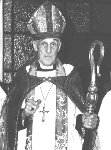 9: 1957-68 Francis Evered Lunt (1900-82),
sometimes nicknamed (how fairly?) 'Evered the Unready', had
a background in student chaplaincy. He had trained for ordination at
the London College of Divinity, and served a curacy in Maidenhead from
1925-31, before moving to St Barnabas Cambridge and completing a
licentiate at University College Durham in 1934 (an unusual academic trajectory). He then became
chaplain of Downing College Cambridge within the Cambridge Pastorate, moving to a similar
role in Oxford, as senior chaplain of the Oxford Pastorate and Rector
of St Aldate's (and also a surrogate, and examining chaplain) in 1943.
In 1951 he became Dean of Bristol, and came to Stepney in 1957,
retiring to Bognor Regis in 1968 (two years earlier, Downing College had appointed him as an honorary
fellow). In 1958 he had been one of sixteen formally nominated for the
post of Bishop of Sydney, but he was not shortlisted. He was an
active supporter of Dame
Cicely Saunders' hospice
movement.
9: 1957-68 Francis Evered Lunt (1900-82),
sometimes nicknamed (how fairly?) 'Evered the Unready', had
a background in student chaplaincy. He had trained for ordination at
the London College of Divinity, and served a curacy in Maidenhead from
1925-31, before moving to St Barnabas Cambridge and completing a
licentiate at University College Durham in 1934 (an unusual academic trajectory). He then became
chaplain of Downing College Cambridge within the Cambridge Pastorate, moving to a similar
role in Oxford, as senior chaplain of the Oxford Pastorate and Rector
of St Aldate's (and also a surrogate, and examining chaplain) in 1943.
In 1951 he became Dean of Bristol, and came to Stepney in 1957,
retiring to Bognor Regis in 1968 (two years earlier, Downing College had appointed him as an honorary
fellow). In 1958 he had been one of sixteen formally nominated for the
post of Bishop of Sydney, but he was not shortlisted. He was an
active supporter of Dame
Cicely Saunders' hospice
movement.

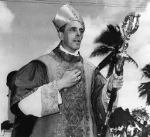

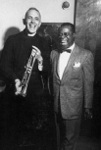
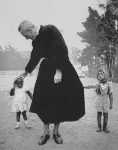
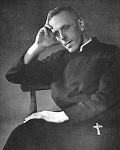 10: 1968-78 [Sir] Ernest Urban Trevor Huddleston CR
(1913-1998) was born in Bedford and attended Lancing College (a Woodard
school in the Anglo-Catholic tradition); after Christ Church Oxford and
Wells Theological College, he served a curacy at St Mark Swindon in
1937 and joined the Community of the Resurrection in Mirfield two years
later, taking vows in 1941. Remarkably, two years later, Fr Raymond Raynes CR, who
had been recalled from the Community's mission station at
Rossetenville, Sophiatown in South Africa because of stress - and was
nursed by Trevor, still a novice - arranged for him to replace him
there, and he became priest-in-charge, and in 1949 the Community's
Provincial in South Africa (and Superintendent of St Peter's School).
These were heady days for the anti-apartheid cause (predating Joost de Blank's involvement) and for the next 13 years he was at the forefront. He earned the nickname Makhalipile ('dauntless one') and the honorific title, at the 1955 African National Congress in Kliptown, Isitwalandwe. He visited the young Nelson Mandela as a young man recovering from TB, and they worked together [both pictured in later life]; he also, famously, acquired a trumpet from Louis Armstrong [pictured] for a young student Hugh Masekela. But when he published Naught for your Comfort
in 1956 - which among other things pointed a finger at American support
for apartheid - the Community judged his life, or at least his
well-being, to be in danger and
despite his protests recalled him. There followed four years as novice
master at Mirfield and at their London house - frustrating, but he did
at least found the Anti-Apartheid movement (later, in 1981, becoming
its president). In 1960 he was elected Bishop of Masasi, Tanzania [then
South Eastern Tanganyika] and he returned to the fray - only to come
back eight years later to the Stepney post. Piers McGrandle Trevor Huddleston: Turbulent Priest (Continuum 2004) writes about this period in his life - Julian Scharf, priest-in-charge of this parish, was one of his chaplains.
His final period in Africa - apart from short visits in retirement -
was as Bishop of Mauritius and Archbishop of the (new) Province of the
Indian Ocean, from 1978-83; he was awarded the United Nations' Gold
Medal in 1982. Back in England once again, he worked from St James Piccadilly for the worldwide
anti-apartheid cause, and had links with theological training at the
ecumenical Queen's College Birmingham, before finally retiring to
Mirfield. Various further honours followed, including (rather unusually
for a friar - did he struggle to accept it?) Knight Commander of the
Order of St Michael & St George in 1997. The simple, much-used
prayer God bless Africa, guard her people, guide her leaders, and give her peace (which exists in various forms) is often attributed to him. On his death, Nelson Mandela said Father
Huddleston was a pillar of wisdom, humility and sacrifice to the
legions of freedom fighters in the darkest moments of the struggle
against apartheid (full text, and more on his links with African leaders, in this blog by Charles Cameron).
10: 1968-78 [Sir] Ernest Urban Trevor Huddleston CR
(1913-1998) was born in Bedford and attended Lancing College (a Woodard
school in the Anglo-Catholic tradition); after Christ Church Oxford and
Wells Theological College, he served a curacy at St Mark Swindon in
1937 and joined the Community of the Resurrection in Mirfield two years
later, taking vows in 1941. Remarkably, two years later, Fr Raymond Raynes CR, who
had been recalled from the Community's mission station at
Rossetenville, Sophiatown in South Africa because of stress - and was
nursed by Trevor, still a novice - arranged for him to replace him
there, and he became priest-in-charge, and in 1949 the Community's
Provincial in South Africa (and Superintendent of St Peter's School).
These were heady days for the anti-apartheid cause (predating Joost de Blank's involvement) and for the next 13 years he was at the forefront. He earned the nickname Makhalipile ('dauntless one') and the honorific title, at the 1955 African National Congress in Kliptown, Isitwalandwe. He visited the young Nelson Mandela as a young man recovering from TB, and they worked together [both pictured in later life]; he also, famously, acquired a trumpet from Louis Armstrong [pictured] for a young student Hugh Masekela. But when he published Naught for your Comfort
in 1956 - which among other things pointed a finger at American support
for apartheid - the Community judged his life, or at least his
well-being, to be in danger and
despite his protests recalled him. There followed four years as novice
master at Mirfield and at their London house - frustrating, but he did
at least found the Anti-Apartheid movement (later, in 1981, becoming
its president). In 1960 he was elected Bishop of Masasi, Tanzania [then
South Eastern Tanganyika] and he returned to the fray - only to come
back eight years later to the Stepney post. Piers McGrandle Trevor Huddleston: Turbulent Priest (Continuum 2004) writes about this period in his life - Julian Scharf, priest-in-charge of this parish, was one of his chaplains.
His final period in Africa - apart from short visits in retirement -
was as Bishop of Mauritius and Archbishop of the (new) Province of the
Indian Ocean, from 1978-83; he was awarded the United Nations' Gold
Medal in 1982. Back in England once again, he worked from St James Piccadilly for the worldwide
anti-apartheid cause, and had links with theological training at the
ecumenical Queen's College Birmingham, before finally retiring to
Mirfield. Various further honours followed, including (rather unusually
for a friar - did he struggle to accept it?) Knight Commander of the
Order of St Michael & St George in 1997. The simple, much-used
prayer God bless Africa, guard her people, guide her leaders, and give her peace (which exists in various forms) is often attributed to him. On his death, Nelson Mandela said Father
Huddleston was a pillar of wisdom, humility and sacrifice to the
legions of freedom fighters in the darkest moments of the struggle
against apartheid (full text, and more on his links with African leaders, in this blog by Charles Cameron).
Huddleston on Hawksmoor
In
1962 the Arts Council had mounted a major exhibition on Hawksmoor - a
stage towards his 'rehabilitation' - and in 1977 Kerry Downes, author
of both the standard and popular books on Hawksmoor (1959 and 1969)
curated a large display at the Whitechapel Art Gallery. This was
criticised by some for failing to set his masterpieces in the
context of urban renewal in the East End - at that time both Christ
Church Spitalfields and St Anne Limehouse were vulnerable. One critic
wrote St George-in-the-East ....is
well looked after and
the modern interior seems open at all times during the day and loved.
Its gaunt and magnificent exterior rises above the dereliction and
desolation of The Highway and Cable Street - great wastes of vacant
land and, now, brutal housing estates going up.
This
prompted the following letter in The Times (20 April 1977) by Bishop
Trevor and Sir John Betjeman (who among his many other involvements was a member of the Council for the Care of Churches):
| In his excellent article on 'Hawksmoor's Neglected Churches' Paul Overy....goes on to plead for an examination of "the place that these great majestic hulks of stone should play in a revitalised human environment in East London". It is certainly an irony that three of these great monuments should stand in Tower Hamlets, one of the poorest boroughs in the country. This is an issue of national significance and it is becoming more urgent every day ... By a strange irony the Church of St George-in-the-East benefited most from the greatest disaster; from having been gutted in the 'blitz' in 1941, it received a large enough sum in war damage to provide for its restoration. It is a splendid parish church with a crypt large enough to make a first class community centre. But both Christ Church and St Anne's are a different case altogether. Because of their sheer magnificence of scale their renovation and restoration today demand financial resources quite beyond the capacity of the local Christian community. And, indeed, it is exceeding doubtful whether the expenditure of vast sums on buildings, however splendid, can possibly today be regarded as a priority by the Church of England as a whole. It seems to us that the time has come for a direct appeal to the nation to save these glorious churches for posterity. We believe that such an appeal in Jubilee Year would meet with a wide and generous response. It would demonstrate unequivocally that we regard the question of urban renewal as a matter of first importance to our country. It would give fresh impetus to aesthetic and cultural priorities in Dockland redevelopment. And - since we are speaking of churches - it would demonstrate our concern as a nation for the preservation and the revitalisation of those values upon which our civilisation is built. |
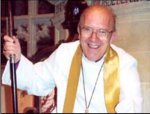
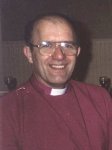
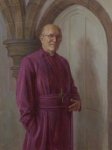
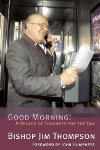 11: 1978-91 James (Jim) Lawton Thompson
(1936-2003), subsequently Bishop of Bath and Wells until his retirement
in 2001, was born in Birmingham and qualified as a chartered
accountant; after National Service in Germany, he studied at Emmanuel
College Cambridge and trained at Cuddesdon where Robert Runcie was
principal. After a curacy in East Ham he returned to Cuddesdon as
chaplain, and in 1971 became Rector of the new ecumenical parish of
Thamesmead before coming to Stepney. As a well-known and effective
broadcaster - for which he
received various awards - he was passionate on issues of social and
racial justice, supporting the marginalised communities of his patch;
as a result, it's said that Margaret Thatcher rejected his nomination to the see of
Birmingham - unlike his next-but-one successor! - though he always claimed to be non-party political. From
1983 until he went to Bath & Wells he was moderator of the
Committee for Relations with People of Other Faiths (as it was then
known), and co-chair of the Inter-Faith Network for the United Kingdom
from 1987-1992. In his later years he also chaired the Children's
Society and the English Churches Housing Trust. He published several
books, including Half Way: Reflections in Middle Life (1986), The Lord's Song (1990), Stepney Calling (1991 - a retrospect of his time here), Why God? (1997) and Good Morning! a Decade of Thoughts for the Day
(2003). The best obituary is by Ruth McCurry (whose husband was Rector
of Stepney, and who still lives and worships in Tower Hamlets deanery,
and works for SPCK) in The Independent on Sunday.
11: 1978-91 James (Jim) Lawton Thompson
(1936-2003), subsequently Bishop of Bath and Wells until his retirement
in 2001, was born in Birmingham and qualified as a chartered
accountant; after National Service in Germany, he studied at Emmanuel
College Cambridge and trained at Cuddesdon where Robert Runcie was
principal. After a curacy in East Ham he returned to Cuddesdon as
chaplain, and in 1971 became Rector of the new ecumenical parish of
Thamesmead before coming to Stepney. As a well-known and effective
broadcaster - for which he
received various awards - he was passionate on issues of social and
racial justice, supporting the marginalised communities of his patch;
as a result, it's said that Margaret Thatcher rejected his nomination to the see of
Birmingham - unlike his next-but-one successor! - though he always claimed to be non-party political. From
1983 until he went to Bath & Wells he was moderator of the
Committee for Relations with People of Other Faiths (as it was then
known), and co-chair of the Inter-Faith Network for the United Kingdom
from 1987-1992. In his later years he also chaired the Children's
Society and the English Churches Housing Trust. He published several
books, including Half Way: Reflections in Middle Life (1986), The Lord's Song (1990), Stepney Calling (1991 - a retrospect of his time here), Why God? (1997) and Good Morning! a Decade of Thoughts for the Day
(2003). The best obituary is by Ruth McCurry (whose husband was Rector
of Stepney, and who still lives and worships in Tower Hamlets deanery,
and works for SPCK) in The Independent on Sunday.
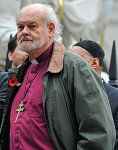
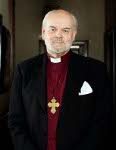
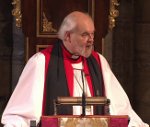
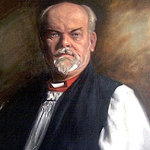
 12: 1992-95 Richard
John Carew Chartres
(b.1947): Bishop Richard, now our diocesan bishop, studied at Trinity
College Cambridge and was ordained in 1973 after training (not without
turbulence) at Cuddesdon and Lincoln Theological Colleges. After a
curacy at St Andrew Bedford he became Robert Runcie's chaplain at St
Albans, moving with him to Canterbury. From 1984-92 he was incumbent of
St Stephen Westminster, director of ordinands, and a professor of
Gresham College, and has maintained a keen interest in higher education
(the Rector of St George's first met him at a chaplains' conference)
and ministry training, as witness his powerful advocacy of St Mellitus
College (which until recently had a base in our crypt). Aided by a
photographic memory for people and places - and by his much-loved wife Caroline
(whose Church Times
columns chronicled how they raised four young children in the heart of
the City when they moved from Stepney) - he retains a close pastoral concern for the area
which he served for five years. In typically colourful phraseology, he describes us, among other things, as East Saxons with attitude who now face the embourgeoisement of the Thames littoral. (He himself claims to be an Irish Huguenot.) Duties
in the Stepney area included serving on the East London Partnership, and
as patron of Tower Hamlets Old People's Welfare Trust. As Bishop of
London, he has a plethora of national roles: in Parliament; with the royal
family; internationally (including our diocesan links with Angola
and Mozambique); though no lover of General Synod, in the Church of England he is a passionate
campaigner for, and (as a
vegetarian who restricts his air travel wherever possible) personal practitioner of, green causes; and is the
lead
bishop for cathedral and church buildings, describing the Church of
England as the least established church in Europe in terms of the financial support it receives from government.
[There are many recent pictures of Bishop Richard online - including
[far right] at the time of the 2011 'Occupy London' camp on the steps
of St Paul's - but fewer of his earlier ministry.]
12: 1992-95 Richard
John Carew Chartres
(b.1947): Bishop Richard, now our diocesan bishop, studied at Trinity
College Cambridge and was ordained in 1973 after training (not without
turbulence) at Cuddesdon and Lincoln Theological Colleges. After a
curacy at St Andrew Bedford he became Robert Runcie's chaplain at St
Albans, moving with him to Canterbury. From 1984-92 he was incumbent of
St Stephen Westminster, director of ordinands, and a professor of
Gresham College, and has maintained a keen interest in higher education
(the Rector of St George's first met him at a chaplains' conference)
and ministry training, as witness his powerful advocacy of St Mellitus
College (which until recently had a base in our crypt). Aided by a
photographic memory for people and places - and by his much-loved wife Caroline
(whose Church Times
columns chronicled how they raised four young children in the heart of
the City when they moved from Stepney) - he retains a close pastoral concern for the area
which he served for five years. In typically colourful phraseology, he describes us, among other things, as East Saxons with attitude who now face the embourgeoisement of the Thames littoral. (He himself claims to be an Irish Huguenot.) Duties
in the Stepney area included serving on the East London Partnership, and
as patron of Tower Hamlets Old People's Welfare Trust. As Bishop of
London, he has a plethora of national roles: in Parliament; with the royal
family; internationally (including our diocesan links with Angola
and Mozambique); though no lover of General Synod, in the Church of England he is a passionate
campaigner for, and (as a
vegetarian who restricts his air travel wherever possible) personal practitioner of, green causes; and is the
lead
bishop for cathedral and church buildings, describing the Church of
England as the least established church in Europe in terms of the financial support it receives from government.
[There are many recent pictures of Bishop Richard online - including
[far right] at the time of the 2011 'Occupy London' camp on the steps
of St Paul's - but fewer of his earlier ministry.]
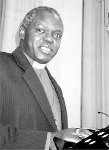
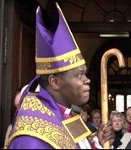
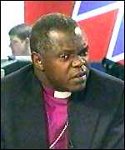
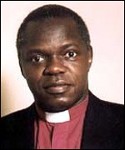
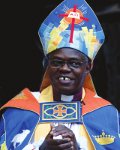
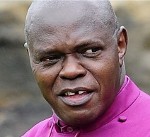 13: 1996-2002 John Tucker
Mugabe Sentamu
(b.1949): previously styled Bishop John, now Archbishop Sentamu, he was
born near Kampala in Uganda, the sixth of thirteen children, and
studied law at Makerere University,
becoming an advocate of the Supreme Court. He was imprisoned for 90
days for
his opposition to Idi Amin's regime before coming to Britain in 1974,
where he read theology at Selwyn College Cambridge (receiving an adult
believer's baptism) and trained for
ordination at Ridley Hall; ordained in 1979, he continued to study -
gaining a doctorate in 1984 on the 'classic' texts of the early 20th
century theologian J.K. Mozley on divine passibility, examining the
question that is both African and unversal 'must God suffer in order to
save?' - while serving variously as assistant chaplain of Selwyn, at a
remand centre, and posts in Southwark diocese, particularly around
Tulse Hill, where he became incumbent of a vibrant group of parishes
(enlivened not least by his own drumming at services), and an honorary
canon. He was consecrated for Stepney in 1996; during this time was an adviser to the Stephen Lawrence judicial enquiry, and in 2002 chaired the Damilola Taylor
review; he was also vocal on the issue of the impact of police 'stop
and search' on the black community, of which he was personally a victim
on several occasions, and on other justice issues. In 2002 he became
Bishop of Birmingham, and a mere three years later Archbishop of York.
He has received many honours, both from universities and as
'Yorkshireman of the Year' - claiming in response that his third name is
'ee-bah-gum' in reverse. Ironically, he shares this name with the
president of Zimbabwe, whom he has roundly denounced, cutting up and
eschewing his clerical collar until he has gone. As a public figure, he
is sharp and prominent (even writing a column for Murdoch's relaunched Sunday Sun),
treading a precarious course between the conservative values that he
espouses - and on which African Christians look to him to speak out -
on matters
such as sexuality, the family and multiculturalism, and the more
liberal values on social justice, including challenging oppression and corruption at
home and abroad, to which he is also committed. [Pictures selected from a huge range of past and present images!]
13: 1996-2002 John Tucker
Mugabe Sentamu
(b.1949): previously styled Bishop John, now Archbishop Sentamu, he was
born near Kampala in Uganda, the sixth of thirteen children, and
studied law at Makerere University,
becoming an advocate of the Supreme Court. He was imprisoned for 90
days for
his opposition to Idi Amin's regime before coming to Britain in 1974,
where he read theology at Selwyn College Cambridge (receiving an adult
believer's baptism) and trained for
ordination at Ridley Hall; ordained in 1979, he continued to study -
gaining a doctorate in 1984 on the 'classic' texts of the early 20th
century theologian J.K. Mozley on divine passibility, examining the
question that is both African and unversal 'must God suffer in order to
save?' - while serving variously as assistant chaplain of Selwyn, at a
remand centre, and posts in Southwark diocese, particularly around
Tulse Hill, where he became incumbent of a vibrant group of parishes
(enlivened not least by his own drumming at services), and an honorary
canon. He was consecrated for Stepney in 1996; during this time was an adviser to the Stephen Lawrence judicial enquiry, and in 2002 chaired the Damilola Taylor
review; he was also vocal on the issue of the impact of police 'stop
and search' on the black community, of which he was personally a victim
on several occasions, and on other justice issues. In 2002 he became
Bishop of Birmingham, and a mere three years later Archbishop of York.
He has received many honours, both from universities and as
'Yorkshireman of the Year' - claiming in response that his third name is
'ee-bah-gum' in reverse. Ironically, he shares this name with the
president of Zimbabwe, whom he has roundly denounced, cutting up and
eschewing his clerical collar until he has gone. As a public figure, he
is sharp and prominent (even writing a column for Murdoch's relaunched Sunday Sun),
treading a precarious course between the conservative values that he
espouses - and on which African Christians look to him to speak out -
on matters
such as sexuality, the family and multiculturalism, and the more
liberal values on social justice, including challenging oppression and corruption at
home and abroad, to which he is also committed. [Pictures selected from a huge range of past and present images!]
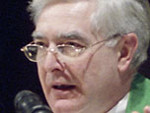



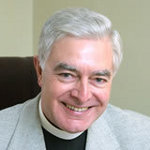 14: 2003-10 Stephen
John Oliver
(b.1948) trained at King's College London, and after posts in Southwell
diocese worked in religious broadcasting at the BBC from 1985-91.
He was then Team Rector of Leeds parish church (and involved in the
production of various texts as a member of the Liturgical Commission)
and from 1997 Canon Precentor of St Paul's Cathedral (planning various
high-profile services) before his appointment to
Stepney. He retired to Nottinghamshire after the death of his
beloved wife Hilary in 2010, a senior nurse, whom he himself nursed
through her long final illness, and wrote Inside Grief
(2013); he continues to preach and broadcast. One of their two sons,
Simon, is associate professor philosophical theology at Nottingham and
honorary Canon Theologian of Southwell Minster.
14: 2003-10 Stephen
John Oliver
(b.1948) trained at King's College London, and after posts in Southwell
diocese worked in religious broadcasting at the BBC from 1985-91.
He was then Team Rector of Leeds parish church (and involved in the
production of various texts as a member of the Liturgical Commission)
and from 1997 Canon Precentor of St Paul's Cathedral (planning various
high-profile services) before his appointment to
Stepney. He retired to Nottinghamshire after the death of his
beloved wife Hilary in 2010, a senior nurse, whom he himself nursed
through her long final illness, and wrote Inside Grief
(2013); he continues to preach and broadcast. One of their two sons,
Simon, is associate professor philosophical theology at Nottingham and
honorary Canon Theologian of Southwell Minster.
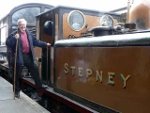
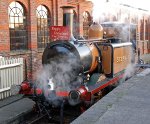
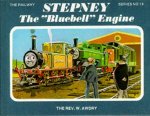 In
April 2008 Bishop Stephen invited the clergy of the Stepney area
on a mystery tour. This turned out to be for an enjoyable ride on the
Bluebell line in Sussex, hauled by 'Stepney the Bluebell engine', with
period carriages. Stepney
was built in 1875, one of 50 Terrier class engines built by William
Stroudley to work lightly-laid branch lines, of which there were a
number in East London. For much of its life, the engine was painted in
'Stroudley's Improved Engine Green', which curiously was a
dirty ochre colour; but after a recent refit and restoration is now in
a less distinctive black with red trim. Clergy were given copies of the
Revd Wilbert Vere Awdry's children's book as a souvenir of the trip!
In
April 2008 Bishop Stephen invited the clergy of the Stepney area
on a mystery tour. This turned out to be for an enjoyable ride on the
Bluebell line in Sussex, hauled by 'Stepney the Bluebell engine', with
period carriages. Stepney
was built in 1875, one of 50 Terrier class engines built by William
Stroudley to work lightly-laid branch lines, of which there were a
number in East London. For much of its life, the engine was painted in
'Stroudley's Improved Engine Green', which curiously was a
dirty ochre colour; but after a recent refit and restoration is now in
a less distinctive black with red trim. Clergy were given copies of the
Revd Wilbert Vere Awdry's children's book as a souvenir of the trip!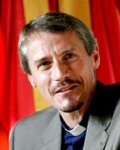
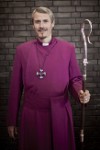
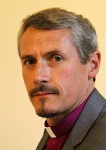
 15: 2011- Adrian Newman
(b.1958) is our current bishop. He studied economics and theology at
Bristol and worked as an enonomist before his ordination (after
training at Trinity College Bristol) in 1985, to St Mark Forest Gate,
in Chelmsford diocese; from 1989 he was Vicar of Hillsborough and
Wadsley Bridge in Sheffield (and for two years their rural dean) before
moving to Birmingham as Rector of St Martin in the Bull Ring, in the
centre of Birmingham, in 1996, five years later becoming a Canon of
Birmingham.
15: 2011- Adrian Newman
(b.1958) is our current bishop. He studied economics and theology at
Bristol and worked as an enonomist before his ordination (after
training at Trinity College Bristol) in 1985, to St Mark Forest Gate,
in Chelmsford diocese; from 1989 he was Vicar of Hillsborough and
Wadsley Bridge in Sheffield (and for two years their rural dean) before
moving to Birmingham as Rector of St Martin in the Bull Ring, in the
centre of Birmingham, in 1996, five years later becoming a Canon of
Birmingham. 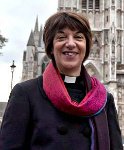 In 2004 he became Dean of Rochester Cathedral, relishing a one-time introduction as the most un-dean like dean in the Church of England. He
and the cathedral had links with both the universities in Kent:
Canterbury Christ Church (an Anglican foundation, once a college of
education) made him an honorary fellow in 2009, and Kent at Canterbury
conferred an honorary degree three years later. Consecrated for Stepney
in 2012, he sees his role as a 'social entrepreneur', promoting human
and gospel flourishing in every way possible; passionate about urban
ministry, one of his first acts was to share with his clergy his
sabbatical research on the subject (under the title 'So Yesterday',
reflecting his fears about disengagement since Faith in the City
25 years previously). He would be the first to acknowledge the key role
of his archdeacon colleague, Rachel Treweek of Hackney (formerly of
Willesden) [right] in
enabling him to make a powerful initial impact on the area, as well as
fulfilling a role on the wider church scene, including being one of six
senior women priests to sit with the House of Bishops pending the
inclusion of women among their number. To the great delight of all with whom she had worked in Stepney, she became the Bishop of Gloucester in 2014: the first female diocesan bishop in the Church of England, and member of the House of Lords.
In 2004 he became Dean of Rochester Cathedral, relishing a one-time introduction as the most un-dean like dean in the Church of England. He
and the cathedral had links with both the universities in Kent:
Canterbury Christ Church (an Anglican foundation, once a college of
education) made him an honorary fellow in 2009, and Kent at Canterbury
conferred an honorary degree three years later. Consecrated for Stepney
in 2012, he sees his role as a 'social entrepreneur', promoting human
and gospel flourishing in every way possible; passionate about urban
ministry, one of his first acts was to share with his clergy his
sabbatical research on the subject (under the title 'So Yesterday',
reflecting his fears about disengagement since Faith in the City
25 years previously). He would be the first to acknowledge the key role
of his archdeacon colleague, Rachel Treweek of Hackney (formerly of
Willesden) [right] in
enabling him to make a powerful initial impact on the area, as well as
fulfilling a role on the wider church scene, including being one of six
senior women priests to sit with the House of Bishops pending the
inclusion of women among their number. To the great delight of all with whom she had worked in Stepney, she became the Bishop of Gloucester in 2014: the first female diocesan bishop in the Church of England, and member of the House of Lords.